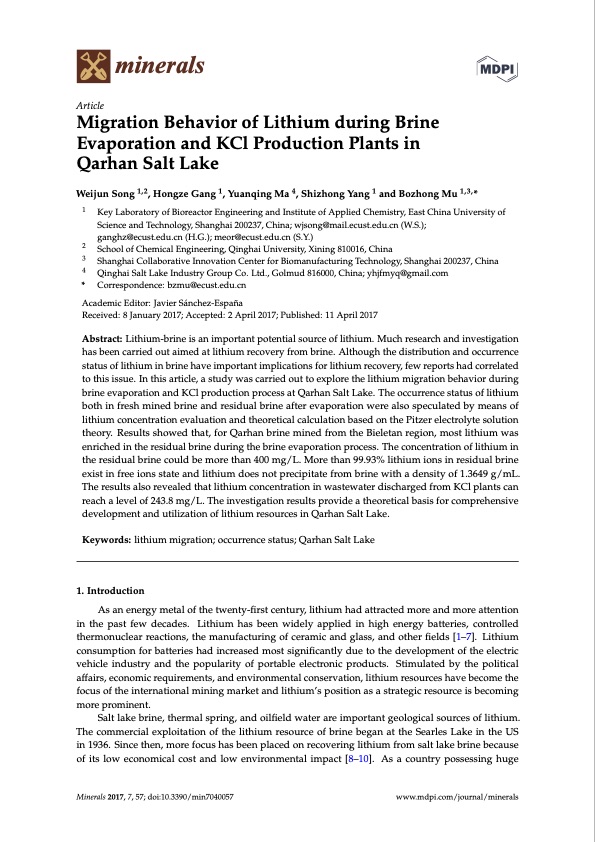
PDF Publication Title:
Text from PDF Page: 001
minerals Article Migration Behavior of Lithium during Brine Evaporation and KCl Production Plants in Qarhan Salt Lake Weijun Song 1,2, Hongze Gang 1, Yuanqing Ma 4, Shizhong Yang 1 and Bozhong Mu 1,3,* 1 2 3 4 Academic Editor: Javier Sánchez-España Received: 8 January 2017; Accepted: 2 April 2017; Published: 11 April 2017 Abstract: Lithium-brine is an important potential source of lithium. Much research and investigation has been carried out aimed at lithium recovery from brine. Although the distribution and occurrence status of lithium in brine have important implications for lithium recovery, few reports had correlated to this issue. In this article, a study was carried out to explore the lithium migration behavior during brine evaporation and KCl production process at Qarhan Salt Lake. The occurrence status of lithium both in fresh mined brine and residual brine after evaporation were also speculated by means of lithium concentration evaluation and theoretical calculation based on the Pitzer electrolyte solution theory. Results showed that, for Qarhan brine mined from the Bieletan region, most lithium was enriched in the residual brine during the brine evaporation process. The concentration of lithium in the residual brine could be more than 400 mg/L. More than 99.93% lithium ions in residual brine exist in free ions state and lithium does not precipitate from brine with a density of 1.3649 g/mL. The results also revealed that lithium concentration in wastewater discharged from KCl plants can reach a level of 243.8 mg/L. The investigation results provide a theoretical basis for comprehensive development and utilization of lithium resources in Qarhan Salt Lake. Keywords: lithium migration; occurrence status; Qarhan Salt Lake 1. Introduction As an energy metal of the twenty-first century, lithium had attracted more and more attention in the past few decades. Lithium has been widely applied in high energy batteries, controlled thermonuclear reactions, the manufacturing of ceramic and glass, and other fields [1–7]. Lithium consumption for batteries had increased most significantly due to the development of the electric vehicle industry and the popularity of portable electronic products. Stimulated by the political affairs, economic requirements, and environmental conservation, lithium resources have become the focus of the international mining market and lithium’s position as a strategic resource is becoming more prominent. Salt lake brine, thermal spring, and oilfield water are important geological sources of lithium. The commercial exploitation of the lithium resource of brine began at the Searles Lake in the US in 1936. Since then, more focus has been placed on recovering lithium from salt lake brine because of its low economical cost and low environmental impact [8–10]. As a country possessing huge Key Laboratory of Bioreactor Engineering and Institute of Applied Chemistry, East China University of Science and Technology, Shanghai 200237, China; wjsong@mail.ecust.edu.cn (W.S.); ganghz@ecust.edu.cn (H.G.); meor@ecust.edu.cn (S.Y.) School of Chemical Engineering, Qinghai University, Xining 810016, China Shanghai Collaborative Innovation Center for Biomanufacturing Technology, Shanghai 200237, China Qinghai Salt Lake Industry Group Co. Ltd., Golmud 816000, China; yhjfmyq@gmail.com * Correspondence: bzmu@ecust.edu.cn Minerals 2017, 7, 57; doi:10.3390/min7040057 www.mdpi.com/journal/mineralsPDF Image | Lithium during Brine Evaporation and KCl Production Plants

PDF Search Title:
Lithium during Brine Evaporation and KCl Production PlantsOriginal File Name Searched:
minerals-07-00057-v2.pdfDIY PDF Search: Google It | Yahoo | Bing
Product and Development Focus for Infinity Turbine
ORC Waste Heat Turbine and ORC System Build Plans: All turbine plans are $10,000 each. This allows you to build a system and then consider licensing for production after you have completed and tested a unit.Redox Flow Battery Technology: With the advent of the new USA tax credits for producing and selling batteries ($35/kW) we are focussing on a simple flow battery using shipping containers as the modular electrolyte storage units with tax credits up to $140,000 per system. Our main focus is on the salt battery. This battery can be used for both thermal and electrical storage applications. We call it the Cogeneration Battery or Cogen Battery. One project is converting salt (brine) based water conditioners to simultaneously produce power. In addition, there are many opportunities to extract Lithium from brine (salt lakes, groundwater, and producer water).Salt water or brine are huge sources for lithium. Most of the worlds lithium is acquired from a brine source. It's even in seawater in a low concentration. Brine is also a byproduct of huge powerplants, which can now use that as an electrolyte and a huge flow battery (which allows storage at the source).We welcome any business and equipment inquiries, as well as licensing our turbines for manufacturing.| CONTACT TEL: 608-238-6001 Email: greg@infinityturbine.com | RSS | AMP |